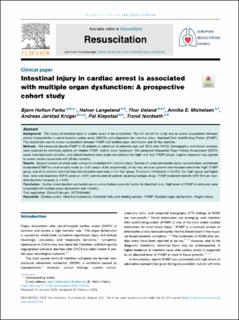| dc.contributor.author | Farbu, Bjørn Hoftun | |
| dc.contributor.author | Langeland, Halvor | |
| dc.contributor.author | Ueland, Thor | |
| dc.contributor.author | Michelsen, Annika Elisabet | |
| dc.contributor.author | Krüger, Andreas Jørstad | |
| dc.contributor.author | Klepstad, Pål | |
| dc.contributor.author | Nordseth, Trond | |
| dc.date.accessioned | 2023-07-24T10:58:21Z | |
| dc.date.available | 2023-07-24T10:58:21Z | |
| dc.date.created | 2023-03-20T09:12:54Z | |
| dc.date.issued | 2023 | |
| dc.identifier.citation | Resuscitation. 2023, 185 . | en_US |
| dc.identifier.issn | 0300-9572 | |
| dc.identifier.uri | https://hdl.handle.net/11250/3081104 | |
| dc.description.abstract | Background
The impact of intestinal injury in cardiac arrest is not established. The first aim of this study was to assess associations between clinical characteristics in out-of-hospital cardiac arrest (OHCA) and a biomarker for intestinal injury, Intestinal Fatty Acid Binding Protein (IFABP). The second aim was to assess associations between IFABP and multiple organ dysfunction and 30-day mortality.
Methods
We measured plasma IFABP in 50 patients at admission to intensive care unit (ICU) after OHCA. Demographic and clinical variables were analysed by stratifying patients on median IFABP, and by linear regression. We compared Sequential Organ Failure Assessment (SOFA) score, haemodynamic variables, and clinical-chemistry tests at day two between the “high” and “low” IFABP groups. Logistic regression was applied to assess factors associated with 30-day mortality.
Results
Several markers of whole body ischaemia correlated with intestinal injury. Duration of arrest and lactate serum concentrations contributed to elevated IFABP in a multivariable model (p < 0.01 and p = 0.04, respectively). At day two, all seven patients who had died were in the “high” IFABP group, and all six patients who had been transferred to ward were in the “low” group. Of patients still treated in the ICU, the “high” group had higher total, renal and respiratory SOFA score (p < 0.01) and included all patients receiving inotropic drugs. IFABP predicted mortality (OR 16.9 per standard deviation increase, p = 0.04).
Conclusion
Cardiac arrest duration and lactate serum concentrations were risk factors for intestinal injury. High levels of IFABP at admission were associated with multiple organ dysfunction and mortality. | en_US |
| dc.language.iso | eng | en_US |
| dc.publisher | Elsevier | en_US |
| dc.rights | Navngivelse 4.0 Internasjonal | * |
| dc.rights.uri | http://creativecommons.org/licenses/by/4.0/deed.no | * |
| dc.title | Intestinal injury in cardiac arrest is associated with multiple organ dysfunction: A prospective cohort study | en_US |
| dc.title.alternative | Intestinal injury in cardiac arrest is associated with multiple organ dysfunction: A prospective cohort study | en_US |
| dc.type | Peer reviewed | en_US |
| dc.type | Journal article | en_US |
| dc.description.version | publishedVersion | en_US |
| dc.source.pagenumber | 0 | en_US |
| dc.source.volume | 185 | en_US |
| dc.source.journal | Resuscitation | en_US |
| dc.identifier.doi | 10.1016/j.resuscitation.2023.109748 | |
| dc.identifier.cristin | 2135141 | |
| cristin.ispublished | true | |
| cristin.fulltext | original | |
| cristin.qualitycode | 2 | |

